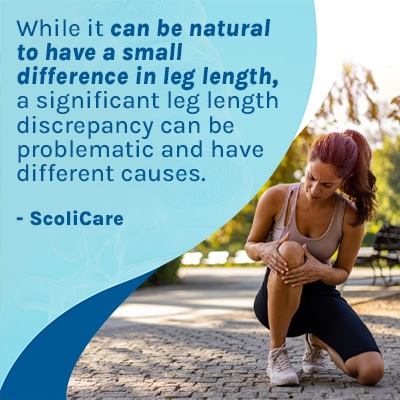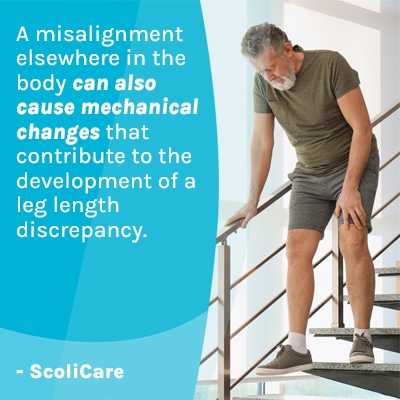Nature favors symmetry, so a disruption to the body’s overall symmetry, including leg length, may be problematic. It’s important to note that a difference in leg length can be anatomical, or it can be due to a misalignment elsewhere in the body.
Leg length discrepancy (LLD), also known as anisomelia and unequal leg length, is a condition involving the legs being different lengths. There are different types of leg length discrepancy. Unequal leg length can be structural or functional, and this will determine the type of treatment needed.
The body’s natural design is based on symmetrical movement, so disruptions to the body’s symmetry can cause it to look and function differently.
Leg Length Discrepancy Causes
Leg length discrepancy occurs if the legs are different lengths.
 While it can be natural to have a small difference in leg length, a significant leg length discrepancy can be problematic and have different causes.
While it can be natural to have a small difference in leg length, a significant leg length discrepancy can be problematic and have different causes.
Leg length discrepancy can be structural or functional; a structural leg length discrepancy means there is a difference in the size of the leg bones, and this can include the thigh bones (femurs) being different lengths, or the tibias (shin bones) differing in size (1).
Some individuals are born with a structural leg length discrepancy (congenital) due to a short or missing shinbone or a short or missing thighbone (1).
A leg length discrepancy can also be acquired for a number of reasons including an injury that doesn’t heal properly, infections, tumors, cysts, or an underlying medical condition.
A misalignment elsewhere in the body can also cause mechanical changes that contribute to the development of a leg length discrepancy.
Scoliosis, for example, is a spinal condition that causes the development of an unnatural lateral spinal curve that also rotates, and as scoliosis introduces uneven forces to the spine and its surroundings, it can also cause postural and movement changes capable of causing a leg length discrepancy (1, 2, 3).
A difference in leg length of approximately 1.5 to 2 cm (5/8 of an inch) may be considered problematic and require treatment (2).
So what are the potential effects of a leg length discrepancy?
Leg Length Discrepancy Effects
The body’s natural design is symmetrical and movement-based, so conditions, injuries, or issues that cause the body to become misaligned can have a number of effects, including disruptions to balance and movement.
If the body is asymmetrical, not only can it look off-balance, it can also affect a person’s mobility and movement patterns (4).
Gait Changes
If one leg is shorter than the other, an uneconomical gait can develop, and the effects of this can be felt throughout the lower body (4).
An economical gait means no extra energy is being expended during the movement; basically, it’s the most efficient way for a person to walk, involving the least expenditure of metabolic energy.
The efficiency of a person’s gait is shaped by a number of factors including muscle strength and balance, age, joint mobility, coordination, and underlying medical conditions.
Walking is a simple movement, but it engages multiple complex systems within the body: the central nervous system, musculoskeletal system, the respiratory system, and more (4).
So if the legs are uneven lengths to a significant degree, a person’s gait can change as the body tries to compensate for the uneven leg length (4)
An uneconomical gait can also cause pain due to uneven load bearing (4).
Pain
When it comes to pain caused by a leg length discrepancy, the larger the discrepancy, the more painful it’s likely to be.
Leg length discrepancy pain can affect the back, hip, knees, and ankles due to uneven forces and uneven weight distribution.
An uneconomical gait can also cause excessive wear and tear on the spine, and this can cause back and nerve pain.
Uneven weight distribution and/or carrying excessive weight can be particularly harmful for the spinal discs, and their health is key to the spine’s overall health and function (2).
A degenerating disc can become a bulging or herniated disc, can compress nearby nerves, and cause pain that radiates throughout the body (2).
And if the limb length inequality is significant enough to cause pain and other noticeable symptoms, treatment may be necessary for any type of improvement.
Muscular Imbalance
Muscles are crucial for bones and joint health; strong balanced muscles can provide the skeletal frame with support and stability needed for healthy movement patterns and posture.
If a leg length discrepancy is contributing to the development of a muscular imbalance, this can further increase the uneven forces being exposed to the spine and its surroundings.
Tight and shorter muscles on the side with the shorter leg are common, and muscles on the side with the longer leg tend to be weaker.
A muscular imbalance can lead to injury, unhealthy movement patterns, and more stress on different parts of the body (2).
Muscle health contributes to bone health; the skeletal system and muscles work together to form a strong and supportive framework for the entire body.
Postural Changes

Postural changes caused by leg length discrepancy can involve a tilted pelvis; the pelvis will sit higher on the side with the longer leg (5).
If the pelvis is tilted, the hips will also be uneven, and this means the weight of the upper body won’t be evenly distributed throughout the lower body, particularly during movement, contributing to the development of an uneconomical gait (4, 5).
And if postural changes aren’t addressed, increasing mechanical changes can occur that further disrupt movement patterns and gait, and the risk of injury may also increase (2, 4, 5).
This also means uneven forces are causing adverse spinal tension, which is why another potential effect of a leg length discrepancy is an unnatural spinal curve (3).
Leg Length Discrepancy Treatment Options
As is common, there are two main types of treatment for a significant leg length discrepancy: surgical treatment or conservative treatment.
Surgical treatment can involve lengthening the shorter leg through manipulating the growth plates to slow growth or removing a piece of bone, and leg lengthening can be achieved through the use of internal and external lengthening devices that separate segments of bone and stimulate new growth (5).
A conservative treatment response is less invasive and is shaped by the type of leg length discrepancy, its cause, patient age, and the severity of its effects.
If the cause is an underlying injury, the injury has to be properly addressed as the cause of the discrepancy.
If an underlying spinal condition like scoliosis and the spine’s misalignment is the cause, the alignment and balance of the spine has to be improved to reduce the uneven forces contributing to the leg length discrepancy.
Through physical therapy, muscular balance and strength may be improved, and this can also improve posture and disruptions to movement.
If healthy movement patterns are restored through treatment, the entire body may feel the effects due to the many systems involved in maintaining an economical gait (4).
Conclusion
While the body’s design is based on symmetry, there can still be small variances that go unnoticed and aren’t considered problematic.
But when a discrepancy is significant, a number of effects can develop, and when it comes to leg length discrepancy, we’re talking about a leg length discrepancy of more than 1.5 centimeters.
A difference in leg length can be caused by malformations in the leg bones that develop in utero (congenital limb length discrepancies), structural differences in the lengths of the femur bones or shin bones, injury, infection, or a misalignment elsewhere in the body causing mechanical and postural changes that can lead to a functional leg length discrepancy.
If a leg length difference is left untreated, the leg length inequality can worsen over time, particularly as the body and spine experience natural age-related degenerative changes, and spinal health can also be disrupted as the asymmetry exposes the lower spine, in particular, to uneven forces.
Here at ScoliCare, innovative nonsurgical solutions work towards restoring the body’s overall symmetry, balance, and stability.
References:
- Vogt B, Gosheger G, Wirth T, Horn J, Rödl R. Leg Length Discrepancy- Treatment Indications and Strategies. Dtsch Arztebl Int. 2020 Jun 12;117(24):405-411. doi: 10.3238/arztebl.2020.0405. PMID: 32865491; PMCID: PMC747769
- Applebaum A, Nessim A, Cho W. Overview and Spinal Implications of Leg Length Discrepancy: Narrative Review. Clin Orthop Surg. 2021 Jun;13(2):127-134. doi: 10.4055/cios20224. Epub 2021 May 18. PMID: 34094002; PMCID: PMC81732
- Xi F, Xue X, Ji E, Zhang Q, Zhao S, Li K, Li Y. Relationship between leg length discrepancy and functional scoliosis in children and adolescents. BMC Musculoskelet Disord. 2025 Apr 30;26(1):428. doi: 10.1186/s12891-025-08693-x. PMID: 40307721; PMCID: PMC12042516
- Khamis S, Carmeli E. Relationship and significance of gait deviations associated with limb length discrepancy: A systematic review. Gait Posture. 2017 Sep;57:115-123. doi: 10.1016/j.gaitpost.2017.05.028. Epub 2017 May 31. PMID: 28600975.
- Zuckerman SL, Lai CS, Shen Y, Cerpa M, Lee NJ, Kerolus MG, Ha AS, Buchanan IA, Leung E, Lehman RA, Lenke LG. Understanding the role of pelvic obliquity and leg length discrepancy in adult spinal deformity patients with coronal malalignment: unlocking the black box. J Neurosurg Spine. 2022 Jan 14;37(1):64-72. doi: 10.3171/2021.10.SPINE21800. PMID: 35171835
- Tagomori H, Kaku N, Tabata T, Tsumura H. A new and simple intraoperative method for correction of leg-length discrepancy in total hip arthroplasty. J Orthop. 2019 May 1;16(5):405-408. doi: 10.1016/j.jor.2019.04.007. PMID: 31193035; PMCID: PMC651426
The post Leg Length Discrepancy: Causes, Effects & Solutions appeared first on ScoliCare.


